![]()
![]()
![]()
Use LEFT and RIGHT arrow keys to navigate between flashcards;
Use UP and DOWN arrow keys to flip the card;
H to show hint;
A reads text to speech;
91 Cards in this Set
- Front
- Back
|
Attempting to identify what materials are present in a sample |
Qualitative Analysis |
|
|
Determining how much of a material is present in a sample. |
Quantitative analysis |
|
|
The branch of chemistry that deals with the separation, identification, and determination of components in a sample. |
Analytical chemistry |
|
|
Methods based on a measured volume and equilibria. |
Titrimetry |
|
|
Methods based measured weight. |
Gravimetry |
|
|
Approaches that rely on measurement of potential, current, resistance, charge... |
Electrochemical |
|
|
Interaction of an analyte with Electromagnetic (EM) radiation |
Spectral Methods |
|
|
Separation of a material due to its interaction with two different phases. |
Chromatography |
|
|
The statistical treatment of data |
Chemometrics |
|
|
GC/MS |
Gas chromatography/mass spectroscopy |
|
|
What are the steps of quantitative analysis? |

|
|
|
The goal is to determine the amount of each component in a sample. |
Complete analysis |
|
|
The goal is to determine the amount of one or a limited number of components without regards total composition. Iron in an ore sample Electrolyte levels in blood Presence of lead in a water sample |
Partial analysis |
|
|
What are the fundamental SI units? |
Length (meter), mass (kg), time (s), temperature (K), and amount (mol). |
|
|
SI derived units with special names |
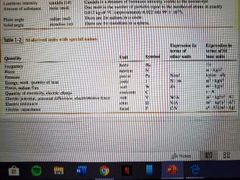
|
|
|
SI Unit Prefixes |
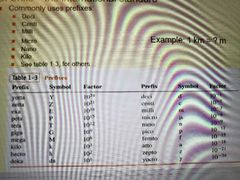
|
|
|
What is the difference between mass and weight? |
Mass is absolute, weight is relative and it is based on gravity. |
|
|
Amount of space occupied by a substance. |
Volume. Measured in liters, ml in pipettes, burettes, and volumetric flasks. |
|
|
A homogeneous mixture of two or more substances. |
Solutions |
|
|
A minor species in solution. |
Solute |
|
|
A major species in solution. |
Solvent |
|
|
Water is the solvent in this type of solution. |
Aqueous solution |
|
|
How much solute is contained in a given volume of solvent. |
Concentration |
|
|
Grams of solute per 100 g of solution. |
Percent concentration or weight percent. |
|
|
Moles of solute per liter of solution. |
Molarity |
|
|
What does 1 ppm convert to? |
1 mg/L or 1 mg/kg |
|
|
What does 1 ppb convert to? |
1 microg/L |
|
|
Massof asubstance per unit of its volume [kg/m3] usedmostly for solid substances |
Density |
|
|
Ratio of a substance mass and the mass of an equal volume of water at 40C [unitless] used mostly for liquids (solutions) |
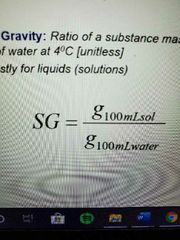
Specific Gravity
|
|
|
Thesimplest number ratio of atoms in a chemical compound: CH2Oempirical formula of formaldehyde, also C2H4O2 glyceraldehyde,C3H6O3 glucose |
Empirical Formula |
|
|
Specifiesthe exact number of atoms in a molecule: CH2O |
Molecular formula |
|
|
Providesstructural details |
Structural formula |
|
|
X-axis |
Abscissa |
|
|
Y-axis |
Ordinate |
|
|
The error that occurs when your eye is not at the same height as the liquid in a burret. |
Parallax |
|
|
The process in which a substance sticks to a surface |
Adsorption |
|
|
Reagents that rapidly absorb moisture from the air in which weighing by difference is necessary |
Hygroscopic |
|
|
The liquid from which a substance precipitates or crystallizes is called the: |
Mother liquor |
|
|
The liquid that passes through the filter is called: |
The filtrate |
|
|
A suspension of solid in liquid |
Slurry |
|
|
Error that arises from a flaw in equipment or the design of an experiment. In principle, it can be discovered and corrected. |
Systematic or determinate error |
|
|
Error that arises from variables in measurement. Always present and cannot be corrected. |
Random or indeterminate error |
|
|
Describes reproducibility of a result. |
Precision |
|
|
Describes how close a measured values is to the true value. |
Accuracy |
|
|
Expresses the margin of uncertainty associated with a measurement |
Absolute uncertainty |
|
|
Compares the size of the absolute uncertainty with the size of it's associated measurement. |
Relative uncertainty = absolute uncertainty/magnitude of measurement |
|
|
Total number of moles of a solute in 1 L |
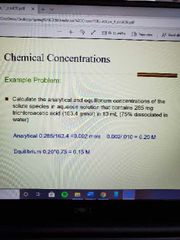
Analytical Molarity |
|
|
Molar concentration of particular species after dissociation |
Equilibrium Molarity NaCl is Na+ and Cl- in solution |
|
|
As the number of measurements increases, what happens to the confidence limits? |
They decrease |
|
|
The probability that the true mean lies within a certain interval. Usually expressed in %. |
Confidence level |
|
|
The range of values within which the population mean is expected to lie within a certain with certain probability for the mean. |
Confidence interval |
|
|
Known solutions of analyte that do not involve the unknown solution to create calibration curves are called |
External standards |
|
|
Being able to distinguish a analyte from other species in the sample |
Selectivity (or specificity) |
|
|
The capability of responding reliably and measurably to changes in analyte concentration. |
Sensitivity |
|
|
A sample containing all components except analyte and it is taken through all steps of the analytical procedure |
Method blank |
|
|
When known quantities of analyte are added to the unknown. From the increased signal, how much analyte in the original unknown can be found. Added substance is the same as analyte. |
Standard addition |
|
|
A change in the analytical signal cause by anything in the sample other than analyte. |
Matrix effect |
|
|
A known amount of compound, different from the analyte, that is added to the unknown. Best procedure when isotope of analyte. |
Internal standard |
|
|
The calibration divided by the standard deviation of the particular point. |
Analytical Sensitivity |
|
|
A system that provides ions when dissolved in water, this increasing the electric conductivity |
Electrolyte Strong ones completely dissolve in water, weak only partially |
|
|
The equilibrium constant for the reaction in which a solid salt dissolves to give it's constituent ions in solution. |
Solubility product |
|
|
A salt will be less soluble if one of its constituent ions is already present in solution. |
The common ion effect |
|
|
Procedures in which we measure the volume of reagent needed to react with analyte |
Volumetric analysis |
|
|
When a titration is carried out in the same procedure but with out analyte to fix titration error. |
Blank titration |
|
|
The validity of an analytical result depends on knowing the amount of one of the reactants used. If a titrant is prepared by dissolving a weight amount of pure reagent in a known volume of solution its concentration can be calculated. This reagent is called |
Primary standard. Should be 99.9% pure |
|
|
An alternative to measuring titrant by volume is to measure the mass of titrant solution delivered. |
Gravimetric titration |
|
|
What happens in back titration? |
Reaction happens first with excess standard, and then the standard is titrated. Good when end point unclear |
|
|
What indicator method is this? Chromate indicator with different Ksp. There is a formation of a second, colored precipitate. Usefully pH range is 7-10. |
Mohr method |
|
|
What indicator method is this? Back titration with thiocyanide, formation of a colored complex. |
Volhard method |
|
|
What indicator method is this? Absorption of In- (indicator) on colloidal AgCl. Colored absorbed species formation. Limited to precipitation reactions leading to colloids. |
Fajan's method |
|
|
Acids produce H+ in aqueous solutions |
Arrhenius Acids |
|
|
Bases produce OH- in aqueous solutions |
Arrhenius Bases |
|
|
A proton donor |
Bronsted acid |
|
|
A proton acceptor |
A Bronsted base |
|
|
An electron acceptor |
Lewis acid |
|
|
Electron donor |
Lewis base |
|
|
A precipitation and volatilization method based on the determination of weight of a substance of known composition that is chemically related to the analyte. |
Gravimetric analysis |
|
|
The species to be determined is precipitated by a reagent that yields a sparingly soluble product, or a product of known composition. |
Precipitation methods |
|
|
The analyte, or it's decomposed products, are volatilized at a suitable temperature. The volatilized species are collected and weighted directly or weighed by difference. |
Volatilization methods |
|
|
What are the 7 steps in gravimetric analysis? |
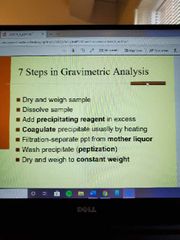
|
|
|
Want the precipitate in gravimetric analysis to be |
Sparingly soluble Readily filterable and washes free of contaminates Unreactive to the atmosphere Of known composition Large particles |
|
|
Formation in a supersaturated solution of the smallest precipitate particles capable of spontaneous growth. |
Nucleation |
|
|
Deposition of ions/molecules on the surface of the solid, nucleated particles |
Particle growth |
|
|
How to keep RSS small: |
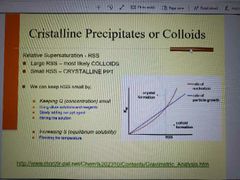
Using dilute solutions and reagents Slowly adding the precipitating agent Stirring the solution Elevating the temperature |
|
|
Heating a solution for an hour after precipitation. |
Digestion |
|
|
Storing the solution unheated overnight. Reduces the amount of trapped impurities |
Aging |
|
|
What is co-precipitation reduced by? |
Using dilute solutions Rapid filtration Removing undesired ions before precipitation |
|
|
What are the ways to filter a solution? |
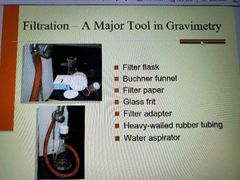
|
|
|
Removes the solvents of the mother liquid from which the precipitate was formed. |
Drying |
|
|
Converts the precipitate to a known composition called weighing form |
Ignition |
|
|
Cyclical metal-organic compounds in which the metal is a part of one or more five or six membered rings |
Chelating Agents. Work to reduce or precipitate |

